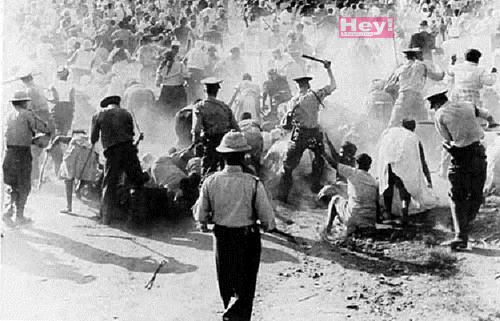By Roberta Nin Feliz
In the history and culture of the Dominican Republic, the desire to be light-skinned has reached monumental proportions. Perhaps the first Dominican tragedy precipitated by the hatred of blackness was under the regime of Rafael Leonidas Trujillo, who ruled the country from 1930 to 1961–even when he was not officially elected. Besides preying on young girls and severely punishing anyone who criticized him, Latin America’s bloodiest dictator was famous for an obsession with whiteness so extreme that he is rumored to have worn powder on his face to appear lighter. Ironically, Haiti, which shares the island of Hispaniola with the DR, is predominantly dark-skinned. His hatred of dark skin caused Trujillo to embark on a campaign of eradicating, harassing and victimizing any Haitians in his reach. Because of this, Trujillo set the precedent for what would become a long legacy of Anti-Haitianism engraved in the Dominican’s mind.

Historical photo of the “Parsley Massacre” (photo from http://elsie-news.over-blog.com)
In an effort to “whiten” the race, Trujillo committed a genocide on the Haitians, known as “El Corte” to Dominicans and “Kout-a” to Haitians. The genocide, widely remembered as the Parsley Massacre, began in October of 1937. Trujillo ordered soldiers to kill between 12,000 and 25,000 Haitians, among them Dominicans that tried to help Haitians. Soldiers traveled to the border towns with machetes, bayonets and rifles to test who was Dominican. People were asked to pronounce the Spanish word for parsley, perejil. Since native creole speakers could not pronounce the ‘r’ correctly, this oral inability cost many their lives. Simply mispronouncing the word was enough to get anyone killed, Haitian or not. After 1937, it became significantly harder for Haitians to enter the Dominican Republic.

Haitians protesting Anti-Haitianism (photo from iacenter.org)
Yet even before Trujillo, periodic conflicts between the Dominican Republic and Haiti had been happening ever since the Haitian Revolution. In fear of France using the DR to invade the newly independent Haitian state and reestablish slavery, Haitians took control of the DR and united the entire island of Hispaniola in 1822. However in 1844, led by Juan Pablo Duarte, the Dominican Republic declared its independence from Haiti. Seemingly, conservative Dominicans never got over Haiti’s invasion and subjugation of the DR.

Protestors’ sign reads: “I am Dominican, Like You” (Photo credit: nydailynews.com
In September of 2013, the Dominican Republic passed a new law repealing the citizenship of thousands of Haitians, from those born to prior immigrants, to those who later entered the country illegally. If a family that arrived in the DR after 1929 can’t document their status, then their citizenship is rescinded. Even if Haitians were born in the country but their grandparents were not citizens, they are also stripped of their citizenship. This ruling by the Supreme Court has left many people effectively stateless with no country to call their own, while also emphasizing Dominican fear of the “blackening” of the Dominican race and of being pulled down economically by Haitians. Since Haiti is an economically depressed third-world country, many Haitians go to the Dominican Republic to find jobs. But the Dominican Republic was not always determined to drive the Haitians out. Ironically, during most of the 20th century the Dominican Republic recruited Haitians to work in the sugarcane fields because of labor shortages.
On May 30, 1961, after many failed assassination attempts against him, Trujillo was gunned down by seven assassins while driving home. After Trujillo’s death, various Presidents have come and gone. Yet anti-Haitianism in the DR has stubbornly remained in existence for hundreds of years, from the time of Touissant L’Ouverture to Rafael Leonidas Trujillo to Danilo Medina. Many Dominicans still feel that Haitians bring the DR down economically and racially, and although some disagree with the Supreme Court’s ruling, they weren’t exactly complaining either. But this hatred of blackness is not exclusive to the Dominican culture. Whether it’s stripping Haitians of their citizenship or killing black teenagers, cultures that institutionalize an irrational fear of dark skin have failed to eradicate and completely oppress the black race, a resilient and powerful one.